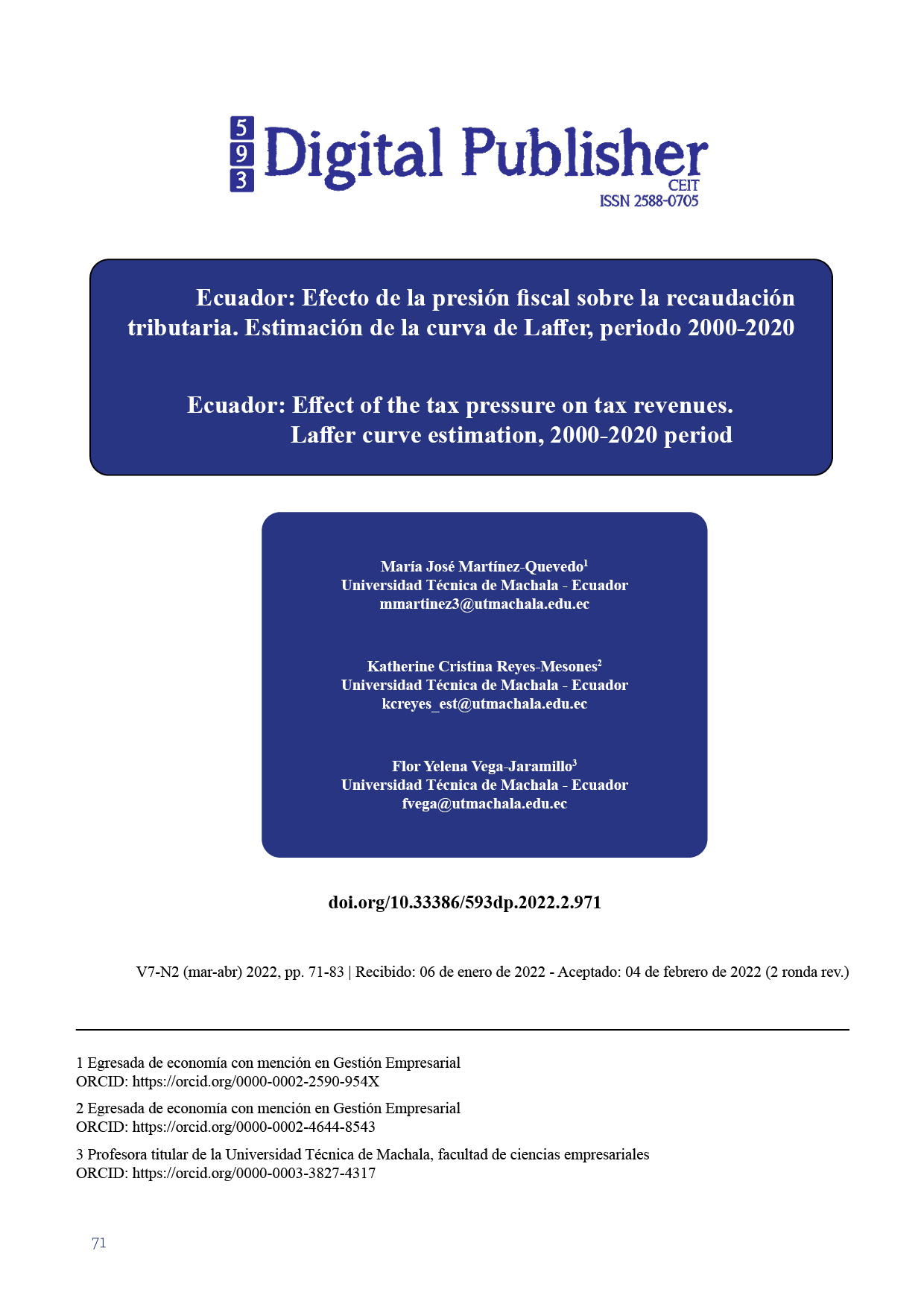Ecuador: Effect of the tax pressure on tax revenues. Laffer curve estimation, 2000-2020 period
Main Article Content
Abstract
For Ecuador, tax revenues play an important role in the financing of the State, since such revenues allow sustaining governmental public spending. In recent years, tax reforms have been aimed at increasing the tax burden in order to increase tax revenues; however, according to theory, tax increases do not necessarily produce positive results. For this reason, the objective of this study is to estimate the effect of the tax burden on tax revenues, through the empirical and econometric application of the Laffer curve, to determine the point of maximization of tax revenues in the Ecuadorian economy during the period 2000 to 2020. Ordinary Least Squares (OLS) and Johansen and Juselius (1990) cointegration methodologies are applied together with an error correction model. The results are statistically significant and the sign of the coefficients correspond to the theory, therefore, the validity of the Laffer curve for Ecuador is ratified, in such a way that, in the short term, the optimal level of tax burden is 19.71%; likewise, the findings found in the long term and through OLS indicate that the optimal point of tax burden that maximizes tax revenues is between 25.39% and 26.49%. A fiscal policy implication is that in the short run the tax burden can be increased by 0.21% and in the long run it can increase by an average of 6.44%. This increase should be oriented towards progressive taxes.
Downloads
Article Details

This work is licensed under a Creative Commons Attribution-NonCommercial-ShareAlike 4.0 International License.
1. Derechos de autor
Las obras que se publican en 593 Digital Publisher CEIT están sujetas a los siguientes términos:
1.1. 593 Digital Publisher CEIT, conserva los derechos patrimoniales (copyright) de las obras publicadas, favorece y permite la reutilización de las mismas bajo la licencia Licencia Creative Commons 4.0 de Reconocimiento-NoComercial-CompartirIgual 4.0, por lo cual se pueden copiar, usar, difundir, transmitir y exponer públicamente, siempre que:
1.1.a. Se cite la autoría y fuente original de su publicación (revista, editorial, URL).
1.1.b. No se usen para fines comerciales u onerosos.
1.1.c. Se mencione la existencia y especificaciones de esta licencia de uso.
References
Altunöz, U. (2017). The application of the Laffer curve in the economy of Turkey. The Journal of International Social Research, 10(50), 654-659. https://www.sosyalarastirmalar.com/articles/the-application-of-the-laffer-curve-in-the-economy-of-turkey.pdf
Balacco, H. (1986). Algunas consideraciones sobre la definición de causalidad de Granger en el análisis econométrico. Económica, 32(2), 207-255. https://revistas.unlp.edu.ar/Economica/article/view/5564
Bejarano, H. (2008, Junio). Verificación empírica de la curva de Laffer en la economía colombiana. Revista Facultad de Ciencias Económicas: Investigación y Reflexión, 16(1), 151-164. http://www.scielo.org.co/pdf/rfce/v16n1/v16n1a11.pdf
Bernal, C. (2010). Metodología de la Investigación: administración, economía, humanidades y ciencias sociales (Tercera Edición ed.). Colombia: PEARSON EDUCACIÓN. https://abacoenred.com/wp-content/uploads/2019/02/El-proyecto-de-investigaci%c3%b3n-F.G.-Arias-2012-pdf.pdf
Bravo, M., y Hidalgo, A. (2020). Análisis de la presión fiscal en el ámbito ecuatoriano, periodo 2004 – 2019. Digital Publisher CEIT, 5(5-1), 80-89. doi:https://doi.org/10.33386/593dp.2020.5-1.325
Cacay, J. C., Ramírez, G., y Campuzano, J. (2021). Efecto del Crecimiento Económico y la Presión Fiscal sobre el Impuesto al Valor Agregado. Revista San Gregorio, 1(47), 111-125. https://revista.sangregorio.edu.ec/index.php/REVISTASANGREGORIO/article/view/1750/8-CACAY
Calva, V., y Ortíz, C. (2017). Efecto de la tasa impositiva sobre la producción: una aproximación empírica mediante la curva de Laffer para Ecuador. Revista Vista Económica, 2(1), 10-22. https://revistas.unl.edu.ec/index.php/economica/article/view/203
Camacho, G., Londoño, S., y Bolívar, E. (2018). Curva de Laffer: una aplicación neoclásica para el Ecuador. Revista Científica SAPIENTIAE, 1(2), 10-21. https://publicacionescd.uleam.edu.ec/index.php/sapientiae/article/view/42
Carrillo, P. (2016). Efecto de la política fiscal en expansión y recesión para Ecuador: Un modelo MSVAR. Cuadernos de Economía, 36(71), 405-439. https://www.redalyc.org/journal/2821/282154593009/html/
Chamba, L., Colcha, R., Moreno, M. d., y Gavilanes, M. (2019). Política tributaria y fiscal del Ecuador. Visionario Digital, 3(3), 327 - 336. doi:https://doi.org/10.33262/visionariodigital.v3i3.886
Dickey, D., y Fuller, W. (1979). Distribution of the Estimators for Autoregressive Time Series with a Unit Root. Journal of the American Statistical Association, 427-431. doi:http://dx.doi.org/10.1080/01621459.1979.10482531
Elliott, G., Rothenberg, T., y Stock, J. (1996). Efficient Tests for an Autoregressive Unit Root. Econometrica, 64(4), 813-836. doi:https://doi.org/10.2307/2171846
Engle, R., y Granger, C. (1987). Co-integration and error correction: representation, estimation, and testing. Econométrica, 55(2), 251-276. doi:https://doi.org/10.2307/1913236
Ferreira, A., Martins, L., y Espanhol, R. (2019). The relationship between tax rates and tax revenues in eurozone member countries - exploring the Laffer curve. Bulletin of Economic Research, 72(2), 1-25. doi:https://doi.org/10.1111/boer.12211
Figueroa, I. (2019). Presión Tributaria del Ecuador, periodo 2000-2018: Un Análisis desde el Enfoque de la Teoría de La Curva de Laffer. Universidad Espíritu Santo, Facultad de Postgrados, Guayaquil. http://repositorio.uees.edu.ec/handle/123456789/3090
Granger, C. (1969). Investigating Causal Relations by Econometric Models and Cross-spectral Methods. Econométrica, 37(3), 424-438. doi:https://doi.org/10.2307/1912791
Gujarati, D., y Porter, D. (2010). Econometría. Mexico: McGRAW-HILL. https://www.academia.edu/40331807/Gujarati_Porter_ECONOMETRIA
Hájeka, J., Šafr, K., Rotschedl, J., y Čadil, J. (2021). The Laffer Curve Decomposed. Ekonomický časopis, 1-26. https://ssrn.com/abstract=3749646
Hernández, R., Fernández, C., y Baptista, M. (2014). Metodología de la investigación. México D.F: McGraw-HIill/Interamericana Editores. http://observatorio.epacartagena.gov.co/wp-content/uploads/2017/08/metodologia-de-la-investigacion-sexta-edicion.compressed.pdf
Herrera, J., Villar, J., y Campo, J. (2020). Tributación en Colombia: Una aproximación teórica y empírica de la Curva de Laffer. Superintendencia de Industria y Comercio (SIC), Grupo de Estudios Económicos. Munich Personal RePEc Archive (MPRA). https://mpra.ub.uni-muenchen.de/105405/
Johansen, S. (1988, June–September). Statistical analysis of cointegration vectors. Journal of Economic Dynamics and Control, 12, 231-254. doi:https://doi.org/10.1016/0165-1889(88)90041-3
Johansen, S., y Juselius, K. (1990). Maximum likelihood estimation and inference on Cointegration —with applications to the demand for money. Oxford Bulletin of Economics and Statistics, 52(2). https://doi.org/10.1111/j.1468-0084.1990.mp52002003.x
Kwiatkowski, D., Phillips, P. C., Schmidt, P., y Shin, Y. (1992). Testing the null hypothesis of stationarity against the alternative of a unit root: How sure are we that economic time series have a unit root? Journal of Econometrics, 54(1-3), 159-178. doi:https://doi.org/10.1016/0304-4076(92)90104-Y
Laffer, A. (1981). Government exactions and Revenue deficiencies. Cato Journal, 1(1), 1-21. https://www.cato.org/sites/cato.org/files/serials/files/cato-journal/1981/5/cj1n1-1.pdf
Laffer, A. (2004). The Laffer Curve: Past, Present, and Future. Backgrounder, 1765(1), 1-16. http://iife.edu.vn/wp-content/uploads/2020/04/Laffer-Couver-Last-Present-and-Future-bg1765.pdf
Lima, E., y Rezende, A. (2019). Um estudo sobre a evolução da carga tributária no Brasil: uma análise a partir da Curva de Laffer. INTERAÇÕES, 20(1), 239-255. doi:http://dx.doi.org/ 10.20435/inter.v0i0.1609
Lin, B., Jia, Z. (2019). Tax rate, government revenue and economic performance: A perspective of Laffer curve. China Economic Review, 56, 1-20. doi:https://doi.org/10.1016/j.chieco.2019.101307
Lordemann, J., y Oropeza, A. (2015). Análisis experimental de la Curva de Laffer y la evasión fiscal en Bolivia. Revista Latinoamericana de Desarrollo Económico(24), 121 - 153. http://www.scielo.org.bo/pdf/rlde/n24/n24_a06.pdf
Mendieta, P. (2018). Verificación del curva de Laffer, caso Ecuador 2016 – 2017. Revista Killkana Sociales, 2(3), 101-108. doi:https://doi.org/10.26871/killkana_social.v2i3.329
Miravete, E., Sein, K., y Thurk, J. (2018). Market power and the Laffer curve. Econométrica, 86(5), 1651–1687. doi:https://doi.org/10.3982/ECTA12307
Moloi, T., y Marwala, T. (2020). Artificial intelligence in economics and finance theories. Springer Nature. doi:https://doi.org/10.1007/978-3-030-42962-1
Morgan, J. (2020). A critique of the Laffer theorem’s macro-narrative consequences for corporate tax avoidance from a Global Wealth Chain perspective. Globalizations, 18(2), 1-21. doi:https://doi.org/10.1080/14747731.2020.1760420
Obregón, M., y Tamez, S. (2020). Factores del comportamiento tributario. VinculaTégica EFAN, 286-297. http://www.web.facpya.uanl.mx/vinculategica/Vinculategica6_1/21%20OBREGON_TAMEZ.pdf
Oliva, N., y Chiliquinga, D. (2017). La Curva de Laffer: ¿Existe suficiente evidencia que la confirme? Revista Propuestas para el Desarrollo, 1(1), 67–78.
Phillips, P. C., y Perron, P. (1988). Testing for a unit root in time series regression. Biometrika, 75(2), 335–346. doi:https://doi.org/10.1093/biomet/75.2.335
Phillips, P., y Ouliaris, S. (1990). Asymptotic Properties of Residual Based Tests for Cointegration. Econometrica, 58(1), 165-193. doi:https://doi.org/10.2307/2938339
Prazmowski, P. (2020). Distorciones fiscales y la curva de Laffer en la República Dominicana. Ciencia y Sociedad, 45(1), 7-23. doi:https://doi.org/10.22206/cys.2020.v45i1.pp7-23
Ramírez, J., y Carrillo, P. (2012). Índice de la Actividad Empresarial no Petrolera (IAE-NP): Una propuesta metodológica de mejora. Servicio de Rentas Internas, Departamento de Estudios Tributarios. Centro de Estudios Fiscales. https://papers.ssrn.com/sol3/papers.cfm?abstract_id=2604173
Salcedo, V., Vidal, M., Caraguay, M., y Sotomayor, J. (2017). La presión fiscal frente a la recaudación tributaria en Ecuador: Medición mediante la curva de Laffer. Revista de Humanidades y Ciencias Sociales y Multidisciplinaria, 3(2), 33-44. http://100cs.cl/index.php/cs/article/view/95
Servicio de Rentas Internas (SRI). (2021, Julio 10). Estudios, Investigaciones e Indicadores. Estudios, Investigaciones e Indicadores: https://www.sri.gob.ec/estudios-investigaciones-e-indicadores#%C3%ADndice
Soldatos, G. (2016). The Laffer Curve, Efficiency, and Tax Policy: A Note. Review of Economics, 67(3), 255–262. doi:https://doi.org/10.1515/roe-2016-0006
Soto, V. (2020). La curva de Laffer en la relación deuda externa-crecimiento económico de México, 1970-2017. Revista Mexicana de Economía y Finanzas, 15(2), 205-225. doi:https://doi.org/10.21919/remef.v15i2.395
Tapia, M., y Alvarado, F. (2018). Impacto de los tipos impositivos en la composición del ingreso fiscal del Ecuador con la aplicación de la curva de Laffer del Ecuador durante el período 2012-2017. Polo del Conocimiento, 3(11), 235-247. https://polodelconocimiento.com/ojs/index.php/es/article/view/792
Varela, L., y Rubiera, F. (2017). Las aglomeraciones urbanas y los impuestos: algunas ideas derivadas de la aplicación de la curva de Laffer al impuesto sobre la renta español en diferentes escenarios espaciales. El Trimestre Económico, 84(333), 121-136. doi:https://doi.org/10.20430/ete.v84i333.264
Wannisk, J. (1978). Taxes, revenues, and the Laffer Curve. The Public Interest, 50, 3-16.




